Chinese Yixyin pottery teapot
This page collects information about Yixing Zisha teapots from various websites and social media platforms. Since my own knowledge on the subject is limited, I cannot guarantee the accuracy of the information provided. Please consider it as a reference only.
Zhu Hongjun (朱鸿钧)
National Senior Craft Artist. Author got the title in 2013. He was born in 1948 in Dingshutown, he began to learn basic skills In 1980. and then he studied advanced technique withmaster Xu Hangtang (徐汉棠) and Gu Shaopei (顾绍培). And hestudied teapotdecoration with teapots carving master Tan Quanhai (谭泉海).
EPudu(萼圃督)
Ceramic artist of the mid-Qing dynasty
Gan Cheng (淦成)
He was a master potter from the late Qing to Republic of China Period.
Yang Pengnia (楊彭年 1772-1854)
He is a master craftsman from Yixing who collaborated with Chen Mansheng (陳曼生) toproduce the so-called Man-sheng teapot (曼生壺).
QangNanlin (王南林)
He was a master craftsman in the mid Qing Dynasty.
Jiang Zhenxiang (蒋貞祥)
He was a ceramic artist of the late Qing dynasty. He also left works during Republic of China period.
Wang Xichen (王熙臣)
He was an artist from the Republic of China and belonged to a factory called "QiminPottery Company (啓民陶器公司)".
Shao Quanzhang (邵全章 1913-1993)
He was a potter from the late Qing Dynasty to the early years of China's civilian government. He was a resident of Shangyuan Village, Yixing. Shao Quanzhang was a descendant of Shao Daheng (邵大恒), a famous potter of the Jia Dao period (1796-1850), whose father, Shao Yunfu (邵云甫), and grand father, Shao Futing (邵夫廷), were famous potters in the late Qing Dynasty and early Republic of China. After Shao Quanzhang became an artist, he often made pots together with Wang Yinchun (王寅春) and Shen Xiaolu (沈孝陆), and his works include Duoqiu pots and antique pots.
Chen Mingyuan (陳鳴遠 1622-1735)
Historically famous potter in Qing dynasty.
Anji (安吉)
A master of teapot making in the late Qing Dynasty.
Zhou Yongfu (周永福)
He was a potter in the late Qing Dynasty.
Wang Dongshi (王東石)
He was a famous potter in the early days of the Republic of China.
Fan Dasheng (范大生)
He was a master craftsman in the Republic of China who won gold medals at the London Art Exhibi tion and the Singapore Nanyang Industrial Fair in 1935.
Cheng Shouzhen (程壽珍 1865-1939)
He was a master craftsman from the late Qing to early Min dynasty, the adopted son of Yu Tingyu (卲友廷). He is said to have made only three types of teapots in his later years. He is known to have won many international awards as a teapot artist. He used the trade name Zhen ji (真記). He is highly sought among collectors. It is also famous for being confused by the fact that his child, Pengen (盤根), uses Shouzhen's "氷水道人" signature as it is.
Shao Jingnan (邵景南)
Shao Jingnan was a man of the Douguang Emperor era (1820-1850). The inscription "留佩 lu-pi" is a pen-name of Shao Jingnan. For this reason, it is generally referred to as a lu-pi jar.
Wuni (烏泥)
It is an unglazed dark gray pottery made by firing dark brown clay. It was developed during the Guangxu period in the late Qing Dynasty. Wrapped Tin Pots are unique to the late Qing Dynasty,
dating from the Jiaqing to Douguang dynasties, and are made of tin on the surface and purple sand on the inside.
Moyuanzhai (墨縁斎)
It is a business name and was produced from the middle to the end of the Qing dynasty. In Japan, there are a relatively large number of inherited pieces. The nail-engraved seal is from the early period, and the square seal is from the middle to late period.
Hu Yaoting (胡耀庭)
He is a regular artist for Tiehuaxuan's (鉄画軒) larger tea pots.
Hui Yigong (恵逸公)
He was a prominent family member of the mid-Qing Dynasty, and is said to be the the two Hui, along with Hui Mengchen (恵孟臣).
The teapot with a mouse mark on the back bottom is an export model made by Yixing for Thailand, marked in Siamese with the 110th anniversary of the Thai dynasty (1892), etc.

Chen Dinghe Pottery Factory (陳鼎和陶器廠)
It was located in Shanghai during the Civil War, at the same time as Tiehuaxuan's (鉄画軒) and others.
Hong Kong Xiangxing Tea Company (香港祥興茶行)
Ordered by Hong Kong Xiangxing Tea Company (香港祥興茶行) to Yi factory (一廠) from 1978-1979. The standard teapots are 4, 6, and 8 cups (190 cc); other types include 4 and 6 cups. The bottom of the pot is marked "Yixing, China (中国宜興)" and the bottom is marked "Xiangxing Tea Company (祥興茶行)" with a black glazed inscription.
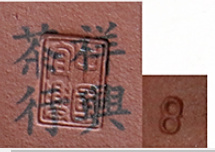
Tudu Pottery Production Cooperative (湯渡陶業生産合作社)
Before the Tudu Pottery Production Cooperative (湯渡陶業生産合作社), a cooperative pottery workshop, which could be said to be the mother factory of the Yixing Tudu Pottery Production Cooperative, was established in 1952-1954 by seven members, including Pei shimin (裴石民), Wu Yungen (呉雲根), Zhu Kexin (朱可心), Shi Fusheng (施福生), Fan Zhenggen (範正根), Shao Liudai (邵六大), and Fan Zude (范祖德), who established a purple sand workshop. The seal is signed in regular script "Exhibited by Yixing Tudu Pottery Production and Cooperation Co (宜興湯渡陶業生産合作社出品).
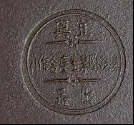
Yixing Shushan Pottery Production Cooperative(宜興蜀山陶業生産合作社)
"Yixing Shushan Pottery Production Cooperative(宜興蜀山陶業生産合作社)" was established in 1954-1958. Initially, the company's seal, "Exhibited by Yixing Yudu Pottery Production Cooperative (宜興湯渡陶業生産合作社出品)" was used as it was. Six months later, the company changed its name to "Yixing Shu Shan Pottery Production Cooperative (宜興蜀山陶業生産合作社出品)". It was used until the establishment of Yi Factory (一廠) in April 1958.
Around 1958, all products were called "cooperative pots," and from 1966 to 1976 they were called "the Cultural Revolution pots," so Yi factory (一廠) pots are from 1977-1997.

Seal of Yi factory (一廠) pots
Around 1958, all products were called "cooperative pots," and from 1966 to 1976 they were called "the Cultural Revolution pots," so Yi factory (一廠) pots are from 1977-1997.
Qing De Tang (清徳堂)
Qing De Tang (清徳堂) is the name of the hall of the famous early Qing dynasty art appreciator Song Lou (宋荦1634-1713). Qing De Tang was a well-known name of the Qing dynasty, and the signature of Qing De Tang can be found on various types of purple sand tea pots until the end of the Republic of China period. Other than the relief caved seal mark on the bottom of the jar, there are no other marks or inscriptions on the pot. In the early period, Qing De Tang's seal was a single-sided square seal in relief caved seal script, but in the later period, it was a twin-sided square seal in seal script.
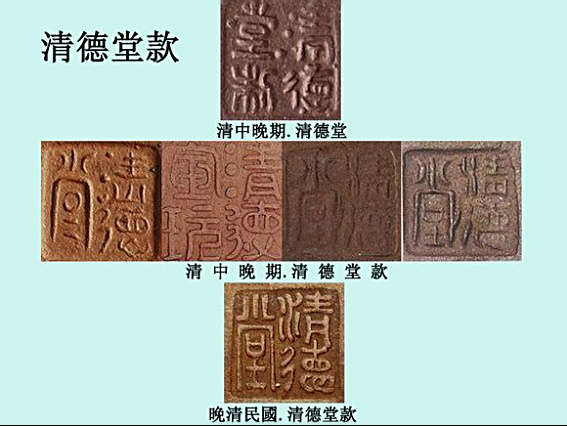
Dating by dragon and flower seals
The period identified by the dragon and flower seal inscriptions is the period from Guangxu 7 to 16 (1881-1890) during the Qing dynasty, when these inscriptions were used on tea pots. During this period, collectors of purple-sand tea pots began to become increasingly popular both at home and abroad, and this can be seen as the beginning of a trend toward a more nostalgic style.
The large twin-sided dragon seal was used in the early period, generally with the dragon design used on Kwang Hsiao coins. The small single-sided dragon seal is slightly later in date and has the same design. Flower seals generally have either a round or a square seal, with the round seal having a treasure design within the outer frame of the floral motif, and the square seal having a bird or animal design or characters within the outer frame of the floral motif. This type of tea pot was used as a common household item.
The dragon and flower seals are large, with single-sided and double-sided seals. The most common type is the single-sided one, in which the dragon and flower designs are elegant and refined, and the dragon design is an imitation of the coins of the Guangxu period.
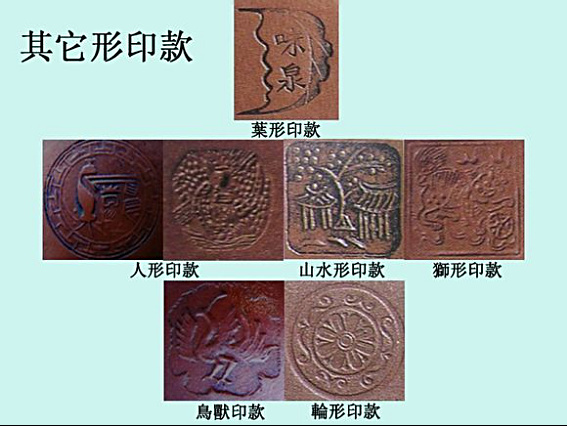
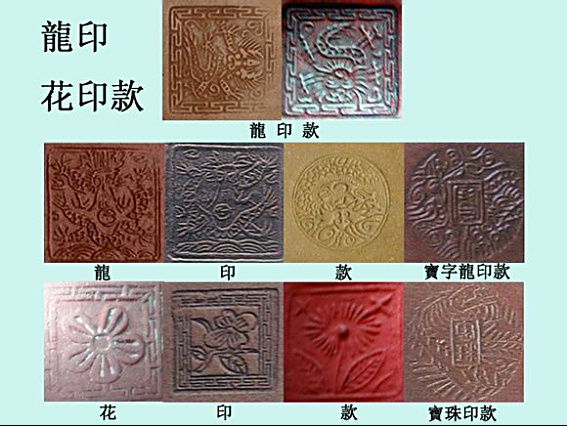
Identification of the date by the signature of kezhai (愙斎)
The date identifiable by the Kezhai inscription is the period from the 21st to the 27th year of Guangxu (1895-1901) during the Qing dynasty. This inscription was used as the signature on purple sand tea vessels collected by Wu Dacheng, a well-known calligrapher and collector of ancient inscriptions on monuments calligraphy.
The bottom of the teapot is inscribed with a relief seal inscription "愙斎" and on the lid is a small inscription of the potter's mark.
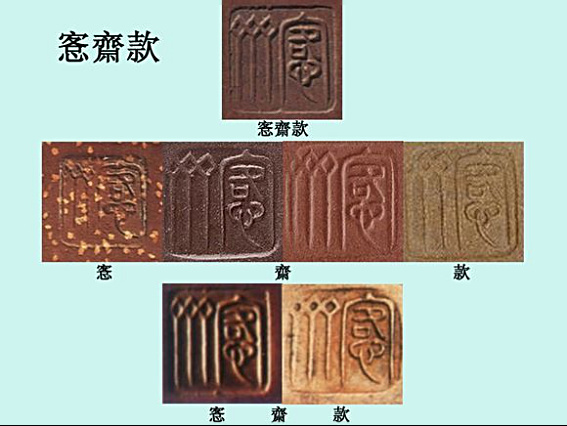
Fan Zhuangnongjia (范莊農家)
According to historical records, since the Ming and Qing dynasties, the Fan (範) family has produced a number of master potters of purple sand tea pots, and many great masters of the tea art have emerged and passed it down to future generations. Fan Zhangen (範章恩), Fan Dingfu (範鼎甫), Fan Zhuangnongjia (範庄農家), Fan Dasheng (範大生), Fan Jinfu(範錦甫), Fan Zhuang(範占), and others have left their mark on the history of purple sand tea pots, which are highly regarded both domestically and internationally. Of these, Fan Daosheng (範大生) is particularly famous for his compilation of the Fan family's tea vessels and tea pots.
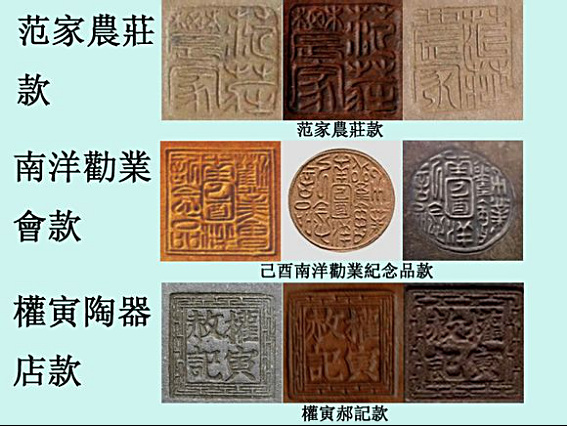
Nanyang Bazaar (南洋勧業会)
In April 1910, the second year of the reign of Emperor Xuan Tong of the Qing Dynasty, the first Nanyang Industrial Exposition was held in Nanjing, China. The Nanyang Expo was the first large-scale international exposition in China's modern history to be organized by the government. The bottom of the pot is seal-engraved with the inscription "Commemorative gift of the Nanyang Industrial Fair (已酉南洋勧業会記念品)" and the lid is inscribed "Guangyu" (光裕).
The Quanyin Pottery Shop (権寅陶器店)'s Articles of Incorporation
The Quanyin Pottery Shop was founded in 1890 by the famous tea pot maker of the late Qing dynasty, Shao Shuangda (邵赦大). Shao was involved in making tea pots, and later devoted himself to running the store. The seal on the lid of the tea pots that he made himself was stamped "Shao Shuada author (邵赦大作者)" and the seal on the bottom of tea pots made to order was stamped "Quanyin-she author (権寅赦記)".

The Yutai Pottery Shop's Articles of Incorporation.
The Yutai Pottery Shop was founded in the Guangxu period of the Qing dynasty. The owner was Jiang Zhenxiang (蔣貞祥), mainly dealing in purple sand pottery. The tea pots made to order were inscribed with the name of Jiang Zhenxiang, with the seal seal '陽羨蔣裕泰制' on the bottom and the oval round seal '裕泰' on the lid. Jiang Zhenxiang also produced tea pots and used the seal '蔣貞祥'.
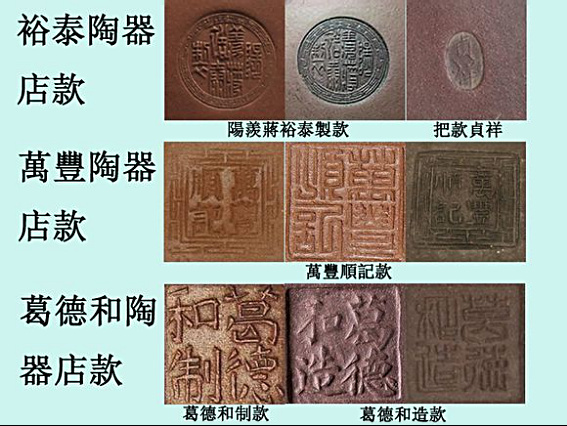
Wanfeng Pottery Shop Articles of Association
Wanfeng Pottery Shop was founded in the Guangxu period of the Qing dynasty. The owner was Jiang Wanfeng (蔣萬豊), and the shop was set up in Shuoshan South Street. The tea pots made to order were stamped "Wanfeng" in seal script. The four-character seal in standard script "萬豊順記" and the small engraving "萬豊" are also present.
The articles of incorporation of Ge Dehe (葛德和) Purple Sand Pottery Shop
Ge Dehe Pottery was founded by Ge Dehe. In the 10th year of the Qing dynasty (1860), the Ge family expanded their business and set up their headquarters in Baitago, Dingshan. In 1910 (Xuan Tong 2) of the Qing dynasty, Ge Wingyun (葛翼雲), a descendant of Ge, opened Ge Dehe Pottery Shop in Shanghai. The address was Lao Beimen Min Guo Lu. Under the jurisdiction of Ge Dehe Pottery in Dingshan, the company built up a track record in Pudong. In 1912, Ge Wingyun opened a pottery business in Nagoya, Japan, in a joint venture with a Japanese merchant. The products traded were those of Yixing Junware and purple sand ceramics. The large Fang seal "葛德和" in standard style was used on the tea pots. Generally, only the store name '葛德和' was stamped on the bottom of the tea pots, with no signature of the potter. With the outbreak of the War of Resistance, only products from Yixing Jun Pottery were dealt in, and not purple sand.
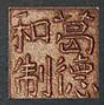
Fu Ji (福記)
The first Fu Ji (福記) was established in the late Qing dynasty and early years of the People's Republic (roughly the same period as “昌記” Chang Ji). It was the name of a pottery workshop in Ding Shu, founded by master potter Cheng Shoufu (程寿福 1853-1926) in the late Qing dynasty. Cheng Shoufu, also known as 陳綬馥 Chen Shoufu, passed away at the age of 73. His ancestral home was in Hangzhou, Zhejiang Province, and he settled in Huaijia Village in the north-east of Chuanbu, where he became the adopted son of the Huai (惠) lineage. He always inscribed his tea pots with signatures such as 'Xiangbun (香凡)' or 'Jingxi Hui Mengsin (荊溪惠孟臣)'. During the Guangxu era, he opened a shop jointly with a merchant from Chaozhou, Guangdong, specialising in pots with the mark 'Fu Ji (福記)' on the handle of the pot. He was a master in the production of small vermilion mud pots at the time, and his technique and precision were outstanding. Most of the tea pots he produced were sold throughout Southeast Asia. On the bottom of his work is the inscription 'Jingxi Hui Mengsin (荊溪惠孟臣)' and below the handle are the two characters 'Fu Ji (福記)'.
Today, the fourth generation of Fuki still produces Fuki tea pots in Yixing.
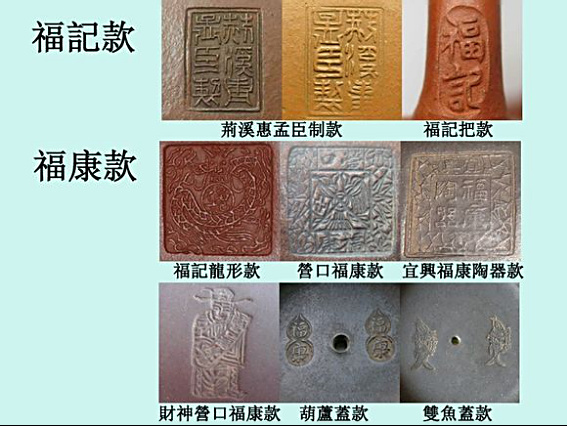
The Fukang Purple Sand Shop's Articles of Incorporation
Fukang (福康) is a prestigious Yixing purple sand family, founded by Xu Hantang (徐漢棠) and Xu Jinsen (徐錦森), grandfather of Xu Xiutang (徐秀棠), two of the greatest pot art masters of the day. Their child, Xu Zujun (徐祖純), was also a master of purple sand tea pots and helped his father in the production of 'Fukang (福康)' tea pots and supervised their production. His younger brother Xu Zuan (徐祖安) was responsible for external sales. Fukang Pottery set up shops in Shanghai, Yingkou and other cities, specialising in selling Fukang purple sand tea pots produced by their own factory.
Fukang teapots were marked with a wide variety of inscriptions. In the very early period, a design commonly referred to as 'Fu Kui Fudan Tou (富貴不断頭)' was used as a signature, with the two characters 'Fuki' (福記) inside. In the middle period, poetic phrases such as "Xiang fujian tongguo de jiaoshu e shishin mengshin (香浮雀舌助我詩人孟臣)" were used, and "Xu ji (徐記)" was added as an inscription. In the latter period, a rectangular piece in relief seal script, "Jingxi hui mengshin sei (福康陶器)". On the bottom, there is a square seal inscription in relief writing in standard script, "Fukang pottery (福康陶器)". It also bears the inscription "Yingkou Fukang (営口福康)" with a military banner and a fortune god. The lid of the jar also bears the inscriptions Fukang (福康), consisting of two gourds, and Fukang (福康), consisting of two fish.
The inscription of Yu Feng Zi Sand Pottery Shop
Yu Feng (豫豊) was the name of a pottery store from the late Qing to the Republic of China. It was founded in 1910 by Wu Tongkan (吳同構) and his father Wu Keinan (吳啓南), who were direct descendants of Wu Yishan (吳頤山) and settled on Shushan South Street. The early version of the signature "Dingyu (鼎裕)" was engraved with a bamboo sword.
In the early stages, Yu Feng tea pots were marked with a design of two dragons and a pearl on the floral border, and with a relief seal using two types of characters, one in Manchu script and the other in Han script. On the lid of the pot, two gourd-shaped inscriptions, "Yu Feng (豫豊)" in relief writing in standard script, were added. After the overthrow of the Qing Dynasty in the Xinhai Revolution (1911), the Chinese characters were removed from the inscription on the bottom of the pot, leaving only the two Chinese characters "Yu Feng" (豫豊). Some were ordered and produced by long-established stores in Tianjin. All Yu Feng tea pots are traditional Hailu Xing pots, and there are also other types, such as chicken-egg pots and egg-box pots. The shape of the hanshu star pot is old-fashioned, unadorned, elegant, and also very practical. It is one of the most popular types of purple sand tea pots from the late Qing Dynasty to the People's Republic of China.
Shiji (施記)
The late Qing master tea pot maker Shi Jinting (施金廷 1877-1950) produced only Shouxing pots during his lifetime. In the early days, the Shouxing pots made by Shi Jinting were not marked in any way. However, later, at the request of the vendor, the pots were marked with the inscription '金廷' or '施記' on the lower part of the jar or on the lid or bottom. In the early period, sword engravings were used, and in the later period wooden seals were used. At the same time, the vendor also placed a 'yu feng (豫豊)' or 'fukang (福康)' inscription (both hollow relief and relief inscriptions) on the lid or bottom of the jar. There were oval or gourd-shaped inscriptions as well as Fang inscriptions, and some used both Man and Han characters. The surrounding decoration is a floral pattern. During the People's Republic of China period, the crests were replaced by two crossed flags of the Nationalist Government.
Yiguzhai (藝古斎)
The founder of Yiguzhai (藝古斎), Cho Songting (趙松亭), founded in 1905. He gave his child, Cho Chien Tai (趙乾泰), his own nostalgic style, and he is widely known as a master potter. He produced small pots of vermillion mud and tub-shaped tubs and exported them to Southeast Asia, where they became very popular among the Thai people. The characteristic of Yiguzhai's work is its nostalgic style, which was mainly in accordance with the tastes of poets in Shanghai who were enthusiastic about collecting pottery at that time. The so-called nostalgic style was actually a fusion of the maker's new ideas on the foundation of the nostalgic style. There are many varieties of sand jars by Yiguzhai, most of which are inscribed with the signature "Dongxie (東溪)".
Zhao Songting (趙松亭) was not only a famous maker of purple sand, but also a businessman with a good management style. In 1925, he and his child, Zhao Qiantai (趙乾泰), rebuilt the Long Kiln Revival Kiln in Chuanbu, where they fired purple sand tea pots, and produced a horizontal vermilion mud pot called the "Gong pot" with the inscription "Gongju (貢局)". He also produced Luxury pots, the surfaces of which were polished with sand to give them a luster, and the rims and lids were covered with gold leaf. They were exported exclusively to Thailand, where they were highly valued.
Famous potters: Cheng Shou-zhen (程寿珍), Jimei (儲銘), Pan De-geun (潘德根)
Trade name: Yiguzhai, Gongju, Dragon wind stamped. After Yongzheng 3 (1726), Mengshin, Mengshin, Level, Kunde, and so on. Each of these is an inscription for the nostalgic Gongju series, which Zhao Songting (趙松亭) personally produced, ordered, or supervised the production of.
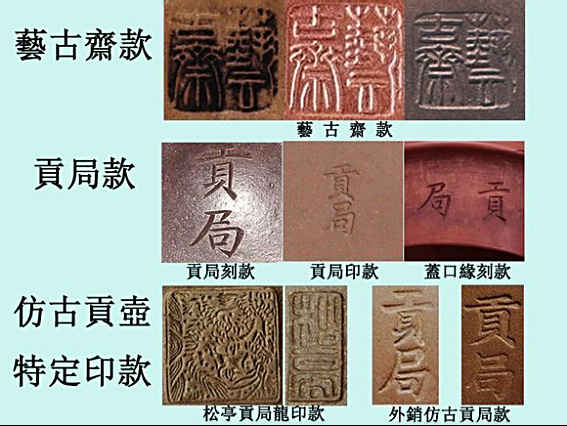


Identification of the date by the Gongju's (貢局) inscription
In the 13th year of the Republic of China (1924), potters were dispersed due to the effects of the fighting in Qi Lu, Jiang Zhe Province. The production of purple sand tea pots also declined sharply. Another war broke out at the beginning of the 14th year of the Republic of China (1925), which slowly subsided in the latter half of the year. Toward the end of the year, Zhao Songting (趙松亭) raised funds to rebuild the Long Kiln, which was renamed the Fuxing Kiln, and produced exclusively red clay horizontal jars called "gong pots (貢壺)". In the early period, the two-character inscription "貢局" or "贡壶" was placed on the bottom of the jar. In the later period, the "Gongju (貢局)" was written in standard script with lines at the top and bottom, and sometimes, "Gongju (貢局)" was written horizontally, engraved with a sword along the rim of the jar lid. In addition, "Gongji (貢局)" was sometimes inscribed within the frame of the floral border in relief writing in standard script with lines above and below, and "Gongju (貢局)" was sometimes inscribed on the lid of the jar in hollow relief writing in standard script. The surface of the tea pot may be polished to a luster with sand or untreated, or gold leaf may be used to cover the mouth, lid rim, and legs of the pot. This continued until the late 30s. The "Gongju (貢局)" signature was used not only by Zhao Songting (趙松亭), but also by other tea pot makers and store owners, such as Fuji (福記) and Changki (昌記).
Inscription of Weihai-weitongqingshun-zao (威海衛同慶順造)

"Weihai-weitongqingshun-zao" was ordered and produced in Yixing by the Weihai (威海) people of Shandong Province from the late Qing Dynasty to the early Chinese colonial period, and the purple sand tea pots were transported back to Weihaiwei, where they were processed. Bell designs were used as decoration on most of the jars, including the beaks, necks, soft-slip holes, and lids. Many of the designs are combinations of dragons, lilies, and noodles. This type of decorative technique combined metal and purple sand tea jars into a single piece, creating a new visual effect.
Many of the copper-tin pots are marked ‘威海衛同慶順造’ and "TUNG KING SHUN FACTORY. WEHAIWEI. NO.1". The Chinese text is in block letters and the English text is in capital letters.
Dating by the articles of incorporation of the Purple Sand Pottery Public Association
In 1915, the Purple Sand Pottery Public Association (then known as the Purple Sand Pottery Public Office, renamed in 1923) was officially established and began using the Purple Sand Pottery Public Association's signatures. In the early period, "Yixing purple sand (宜興紫砂)" was used as a seal of approval for the Haimon side in the hollow relief or relief standard script. At the end of October of the 35th year of the Republic of China (1946), the Yixing County Pottery Industry Association of Purple Sand was dissolved and replaced by the Yudu Dan Products Cooperative. The Purple Sand Pottery Association's logo is no longer used, ending a history of more than 30 years (1915-1946).
Yongtai company (永泰公司)
Yongtai Company, founded by Jiang Zuoxin (江祖臣), ran a pottery business in Shanghai from the early 20th century until his death in the 30s.
Note: Sir Jiang Zan (江案卿) is not Jiang Zuoxin (江祖臣). Many sources refer to him as the same person, but this is incorrect.
Incorporation of the Utilized Pottery Co (利用陶器公司)
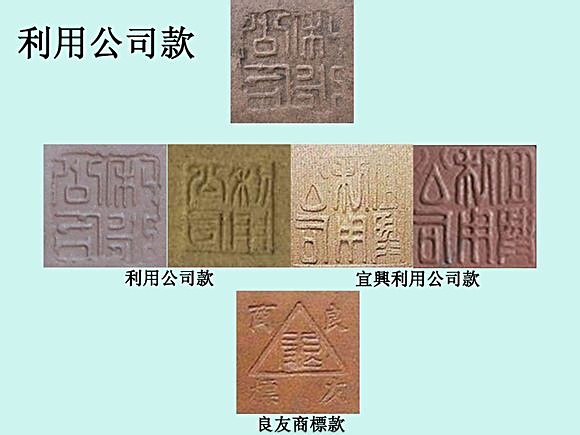
In 1915, Zhou Wenbo and Shao Weiyu jointly founded the Utilization Company (利用公司), which replaced the Utilization Company. In 1915, the company was replaced by the Utilization Pottery Company (利用陶器), which was jointly established by Zhou Wenbai (周文伯) and Shao Weiru (邵偉如). The following year, the Liyong Pottery Shop (利永陶器店) was established in Yuyuan, Shanghai. It sold exclusively purple sand tea pots. In the early years, the company's signatures included " Utility Company of Yixing (宜興利用公司)" in relief seal script and "Utility Company (利用公司)" in relief script and hollow relief script. On the lid, the tea pot maker's small square seal was also added. In the late 1920s, a square seal "Shengxie (盛協)" in standard script was used, and later, "Yangxianmingcha (陽羨名茶)" in relief clerical script was used. In the 30s, the famous "Liangyou Trademark (良友商標)" was established, with the inscription "Liangyou Trademark (良友商標)" in standard script in the form of triangles or squares with double lines within the design.
Incorporation of Tiehuaxuan (鉄画軒) Purple Sand Pottery Shop
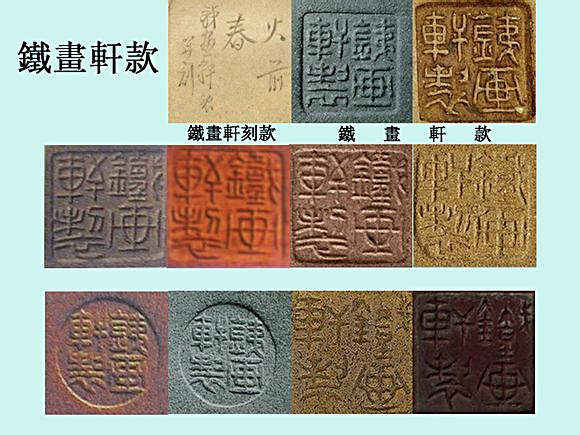
Tiehuaxuan (鉄画軒) Purple Sand Pottery Shop was established in Shanghai in 1900 to trade in Yixing ceramics. The founder, Dai Guobao (戴国宝), was once a master potter who painted flower patterns on ceramics with an iron needle. In the early days, Tiehuaxuan engraved the three characters "鉄画軒" in vertical writing on tea pots as his signature. The engraving method using a knife was bold, and there are two types of engraving, one in standard script and the other in running script. In the later period, there are two types of inscriptions: large pot inscriptions and small pot inscriptions. The large pot seal was a large square or round seal on the bottom of the pot with the relief seal script "鉄画軒制". The small pot had a small, long seal on the bottom with the relief writing in standard script, "鉄画軒制". The pot lid and handle have the signature of the tea pot maker. The owner's inscription is "戴氏 (Dai Shi)" and there are also inscriptions "Jade Ping Sheng" and "Jade Taoist" on the lid and handle.
The purple sand vessels are each signed "玉屏生 (Yu Ping Sheng)" or "鉄画軒" some in standard script and some in running script.
Wu Desheng (吳德盛) Pottery Shop
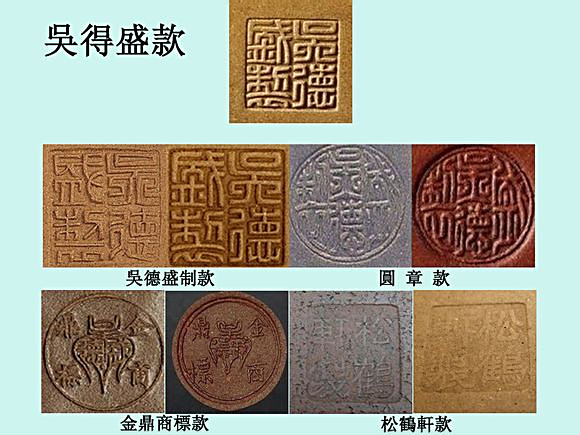
The Wu Desheng (吳德盛) Pottery Shop was established in 1916 by Wu Hanwen (吳漢文), and the store was located near Cheng Jiao Bridge in Yixing County. In the early days, a small square seal inscription in relief seal script, "吳德盛" was placed on both the bottom and lid of the jar. Later, a larger square seal called "吳德盛制" in relief seal script was used. In the middle period, a large round seal called "吳德盛制" or "宜興吳德盛制" in relief seal script was used. In the late 1920s, the shop owner Wu Hanwen established the famous trademark of the Wu Desheng shop, "金鼎商標" the Jin Ding trademark.
The Jin Ding trademark is a square seal with a design of a ding (three-legged kettle) in the center and a relief seal script "Jin Ding trademark", which was used as a seal for tea pots made to order at Wu Desheng's shop. In the later period, Wu Hanwen also added the "松鶴軒 (Song He shop)" square seal in standard script to his tea pots. The inscriptions "吳德盛" or "金鼎商標" were placed on the bottom of the jar, and the lid was generally marked with a small square seal of the teapot maker. Because the store went bankrupt after the outbreak of the War of Resistance, the "吳德盛" and "金鼎商標" inscriptions were not used until the end of 1939.
Incorporation of The Chen Dinghe (陳鼎和) Purple Sand Pottery Shop

The Chen Dinghe (陳鼎和) Purple Sand Pottery Shop was founded in 1916 by Chen Yuanming (陳元明), the president of the shop, and had branches in Shanghai and Yixing. In the early years, a large square seal with the name "陳鼎和" in relief standard script was placed on the bottom of the pots, and in the middle period, a large square seal with the name "陳鼎和" in relief standard script and a seal script "陳鼎和陶器廠 (Chen Dinghe Pottery Factory)" were used in combination. In the latter half of the period, the large square seal "陳鼎和" and the maker's signature were used again. Some of the signatures are written in English.
He mainly produced and sold purple sand ceramics. The products included purple sand tea pots, tea bowls, warming drum pots (drum-shaped pots with drinking cups attached; the cups were filled with hot water on the outside), brush caddies, brush washes, and flower vases. The products were stamped with the seal "陳鼎和陶器廠" and a round seal "陳鼎和" in relief seal script. Export ceramics were stamped "C.T.H.CO" in English. The tea ceremony vase has a shiny surface and is engraved with the Tang poem "Fengqiao Yabo" (Staying at the Maple Bridge at Night). The lid of the pot bears the inscription "茗茶清香" and the bottom of the pot bears a round seal stamped "陳鼎和造" in relief seal script. A private collector in the United States has a skin-colored gourd-shaped tea pot with a lion-shaped handle on the lid and a plum branch-shaped tea pot with yellow, pink, and green glaze on the outside. The bottoms of the pots are inscribed with "China" and "C.T.H.CO," respectively, indicating that they were exported by Chen Dinghe at that time.
Mao shunsheng (毛順生) pottery factory
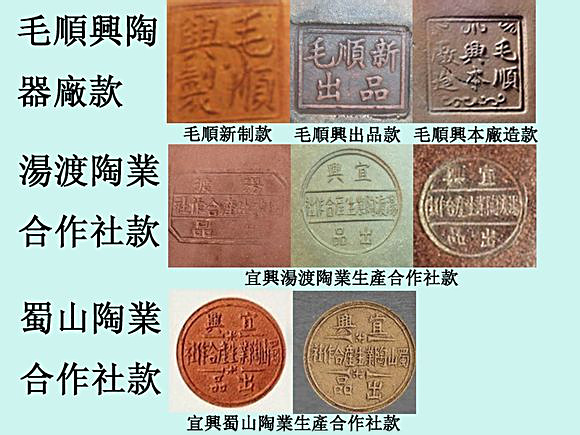
Mao shunsheng (毛順生) was, whose name was Shunsheng (順興), a major potter before the liberation of China, founded the Mao Shunxing Pottery Factory (毛順興陶器廠) in 1932, which became a famous Yixing purple sand store. He was a famous potter of Yixing purple sand, and his signatures were often in the standard script of "毛順興制", "毛順興出品", "毛順興本廠造", or "毛順興陶器廠造".
The most famous tea pot makers include Mao Sunxing (毛順興), Mao Zhensheng (毛振聲), Zhu Kexin (朱可心), Wang Inchun (王寅春), Wu Yungen (吳雲根), and Shen Xiaolu (沈孝鹿), who engraved "任淦庭 (Ren Genting)" and "谈泉明 (tan quanming)" as their inscriptions.
Dated by the signature of Yixing Tang Du Pottery Production Cooperative Co. (宜興湯渡陶業生産合作社)
In February 1952, Tang Du Pottery Production Cooperative was founded, and by the end of 1952, the production of purple sand ware was gradually recovering, and the Yixing Purple Sand Production and Sales Union Office was also established.
In October 1954, seven members, Pei Shimin (裴石民), Wu Yungen (吳雲根), Zhu Kexin (朱可心), Shi Fusheng(施福生), Fan Zhenggen (範正根), Shao Liuda (邵六大), and Fan Zude (範祖德), established a purple sand factory, entrusted its management to Tang Du Pottery Production Cooperative, and soon began using the Yixing Tang Du Pottery Production Cooperative's signature.
The signature "宜興湯渡陶業生産合作社出品 (Exhibited by Yixing Tang Du Pottery Production Cooperative)" in block letters was used. The characters are inscribed from right to left, which is different from the current left-to-right direction. The upper inscription reads "宜興" the middle "湯渡陶業生産合作社" and the lower "出品". These inscriptions were used by the producers who joined the Purple Sand Factory, as well as by private tea pot makers and suppliers. The inscription remained in use until six months after the establishment of the Yixing County Shushan Pottery Industrial Cooperative.
Incorporation of Yixing County Shushan Pottery Production Cooperation Company (宜興県蜀山陶業生產合作社)
From the end of 1955 to the beginning of 1956, a partnership between Shu Shan and the purple sand Producers in the Qianqiu area was realized and the Yixing County Shu Shan Pottery Production Cooperative was established. At the time of its establishment, the company was under the sign "宜興湯渡陶業生産合作社出品 (Yixing Tang Du Pottery Production Cooperative Company)". After half a year, a high quality tea pot for export was produced with the inscription "宜興県蜀山陶業生產合作社出品 (Yixing County Shushan Pottery Production Cooperation Company)". The inscriptions were inscribed from right to left, different from the current left-to-right direction. The upper part of the inscription reads "宜興", the middle part "宜興県蜀山陶業生產合作社", and the bottom part "出品". This signature was used by the company's own employees, as well as by private tea pot makers and suppliers. The signature remained in use until April 1958, when the ‘宜興紫砂工芸廠’ (Yixing Purple Sand Craft Factory) was established.
Yixing Purple Sand Crafts Factory (宜興紫砂工芸廠), "中国宜興 (China Yixing)" and other inscriptions from the 50s to the 90s.
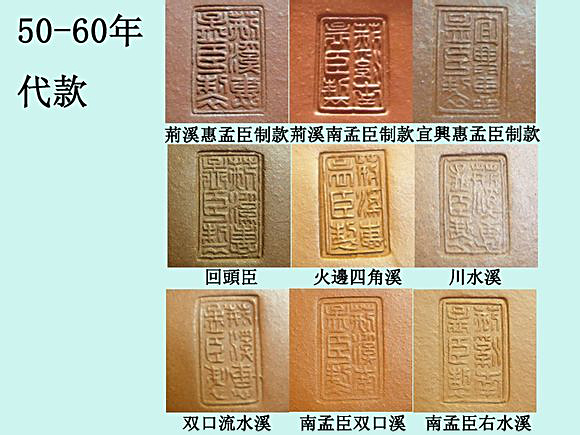
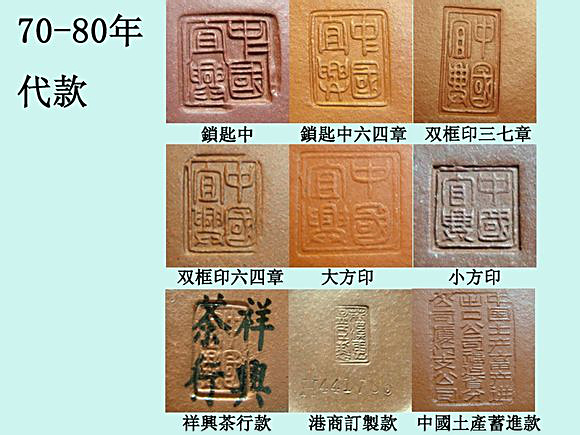
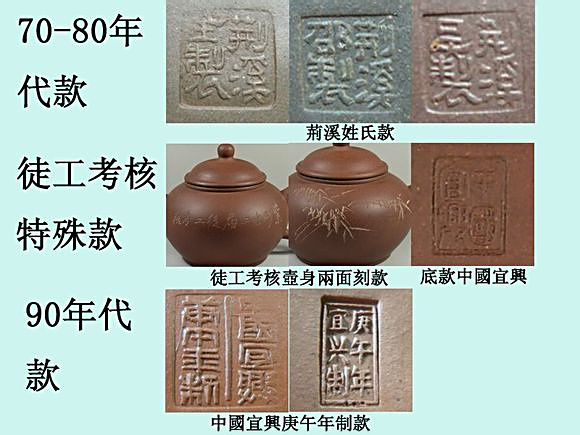
The Yixing Purple Sand Craft Factory, established in April 1958, continued until 1997.